Accounting and Society Answer 2022
VerifiedAdded on 2022/10/15
|11
|2901
|27
AI Summary
Contribute Materials
Your contribution can guide someone’s learning journey. Share your
documents today.
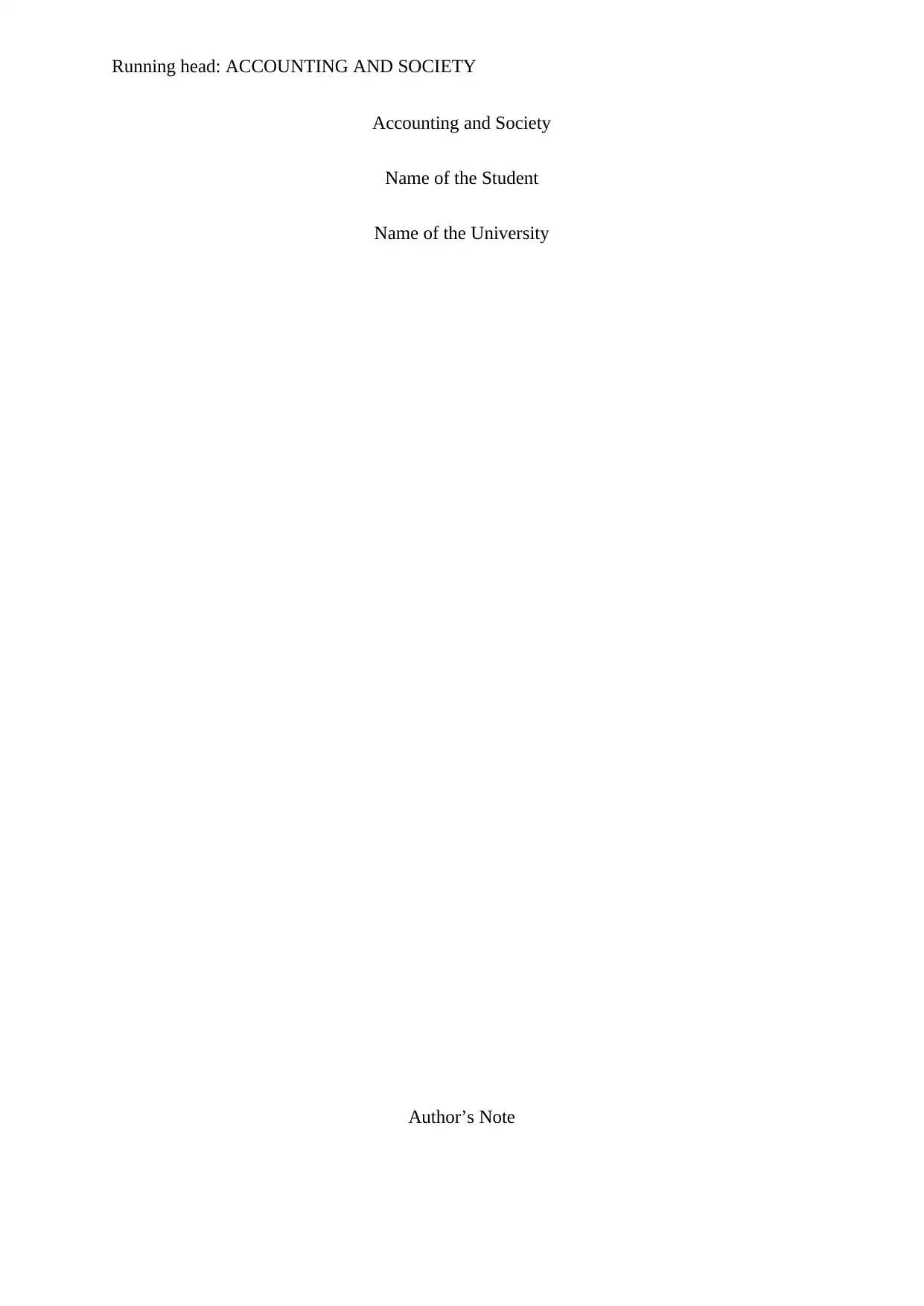
Running head: ACCOUNTING AND SOCIETY
Accounting and Society
Name of the Student
Name of the University
Author’s Note
Accounting and Society
Name of the Student
Name of the University
Author’s Note
Secure Best Marks with AI Grader
Need help grading? Try our AI Grader for instant feedback on your assignments.
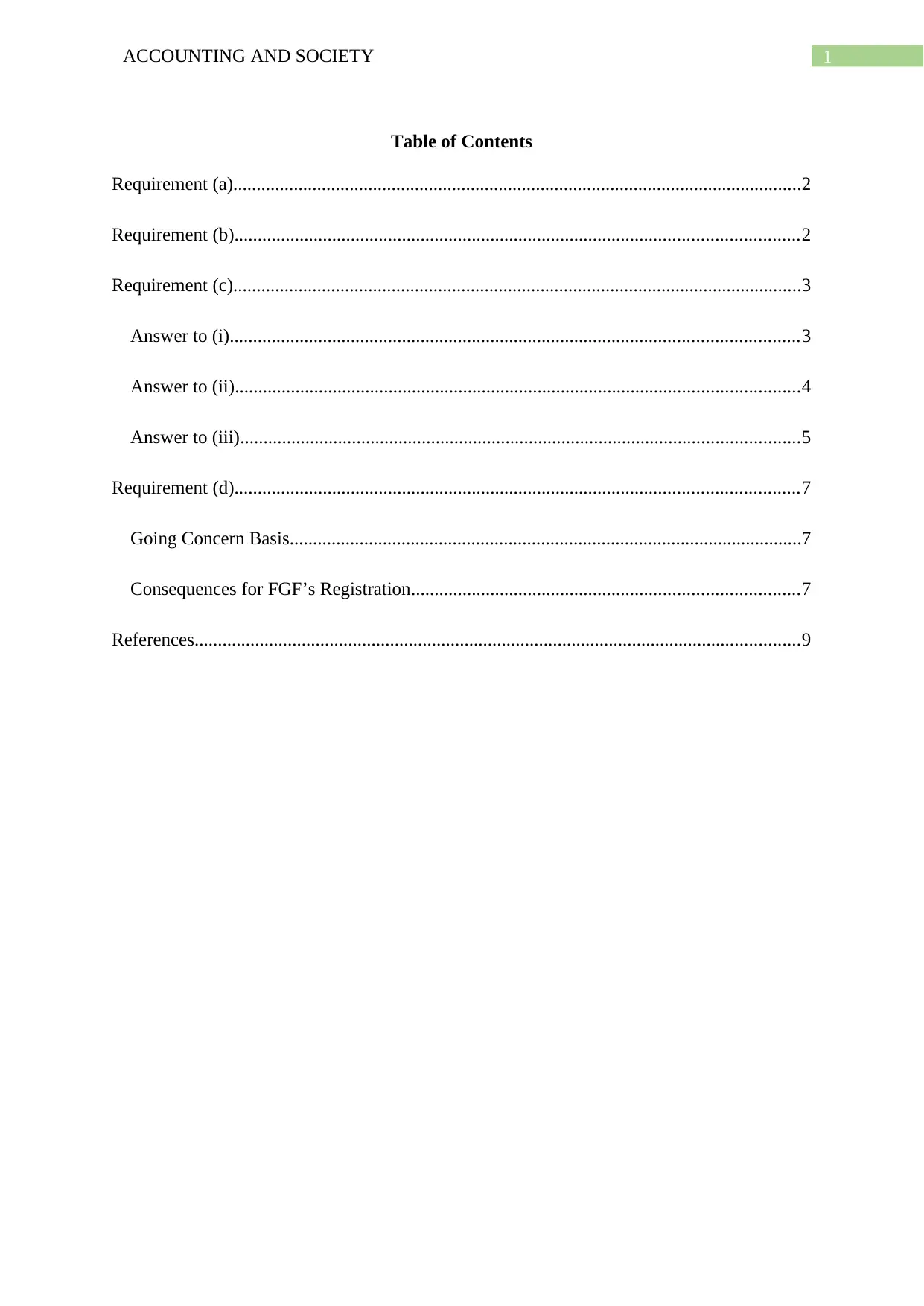
1ACCOUNTING AND SOCIETY
Table of Contents
Requirement (a)..........................................................................................................................2
Requirement (b).........................................................................................................................2
Requirement (c)..........................................................................................................................3
Answer to (i)..........................................................................................................................3
Answer to (ii).........................................................................................................................4
Answer to (iii)........................................................................................................................5
Requirement (d).........................................................................................................................7
Going Concern Basis..............................................................................................................7
Consequences for FGF’s Registration...................................................................................7
References..................................................................................................................................9
Table of Contents
Requirement (a)..........................................................................................................................2
Requirement (b).........................................................................................................................2
Requirement (c)..........................................................................................................................3
Answer to (i)..........................................................................................................................3
Answer to (ii).........................................................................................................................4
Answer to (iii)........................................................................................................................5
Requirement (d).........................................................................................................................7
Going Concern Basis..............................................................................................................7
Consequences for FGF’s Registration...................................................................................7
References..................................................................................................................................9
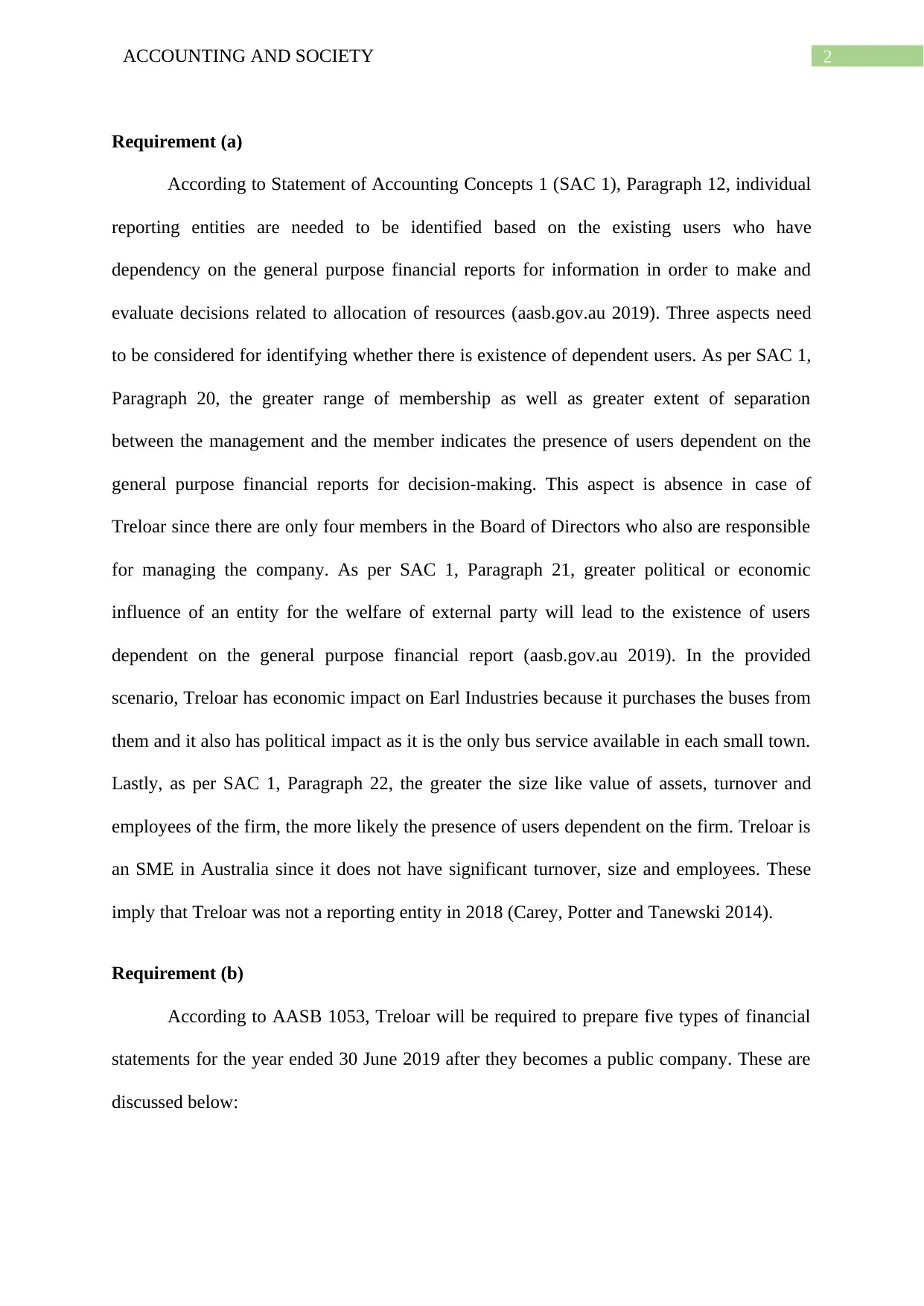
2ACCOUNTING AND SOCIETY
Requirement (a)
According to Statement of Accounting Concepts 1 (SAC 1), Paragraph 12, individual
reporting entities are needed to be identified based on the existing users who have
dependency on the general purpose financial reports for information in order to make and
evaluate decisions related to allocation of resources (aasb.gov.au 2019). Three aspects need
to be considered for identifying whether there is existence of dependent users. As per SAC 1,
Paragraph 20, the greater range of membership as well as greater extent of separation
between the management and the member indicates the presence of users dependent on the
general purpose financial reports for decision-making. This aspect is absence in case of
Treloar since there are only four members in the Board of Directors who also are responsible
for managing the company. As per SAC 1, Paragraph 21, greater political or economic
influence of an entity for the welfare of external party will lead to the existence of users
dependent on the general purpose financial report (aasb.gov.au 2019). In the provided
scenario, Treloar has economic impact on Earl Industries because it purchases the buses from
them and it also has political impact as it is the only bus service available in each small town.
Lastly, as per SAC 1, Paragraph 22, the greater the size like value of assets, turnover and
employees of the firm, the more likely the presence of users dependent on the firm. Treloar is
an SME in Australia since it does not have significant turnover, size and employees. These
imply that Treloar was not a reporting entity in 2018 (Carey, Potter and Tanewski 2014).
Requirement (b)
According to AASB 1053, Treloar will be required to prepare five types of financial
statements for the year ended 30 June 2019 after they becomes a public company. These are
discussed below:
Requirement (a)
According to Statement of Accounting Concepts 1 (SAC 1), Paragraph 12, individual
reporting entities are needed to be identified based on the existing users who have
dependency on the general purpose financial reports for information in order to make and
evaluate decisions related to allocation of resources (aasb.gov.au 2019). Three aspects need
to be considered for identifying whether there is existence of dependent users. As per SAC 1,
Paragraph 20, the greater range of membership as well as greater extent of separation
between the management and the member indicates the presence of users dependent on the
general purpose financial reports for decision-making. This aspect is absence in case of
Treloar since there are only four members in the Board of Directors who also are responsible
for managing the company. As per SAC 1, Paragraph 21, greater political or economic
influence of an entity for the welfare of external party will lead to the existence of users
dependent on the general purpose financial report (aasb.gov.au 2019). In the provided
scenario, Treloar has economic impact on Earl Industries because it purchases the buses from
them and it also has political impact as it is the only bus service available in each small town.
Lastly, as per SAC 1, Paragraph 22, the greater the size like value of assets, turnover and
employees of the firm, the more likely the presence of users dependent on the firm. Treloar is
an SME in Australia since it does not have significant turnover, size and employees. These
imply that Treloar was not a reporting entity in 2018 (Carey, Potter and Tanewski 2014).
Requirement (b)
According to AASB 1053, Treloar will be required to prepare five types of financial
statements for the year ended 30 June 2019 after they becomes a public company. These are
discussed below:
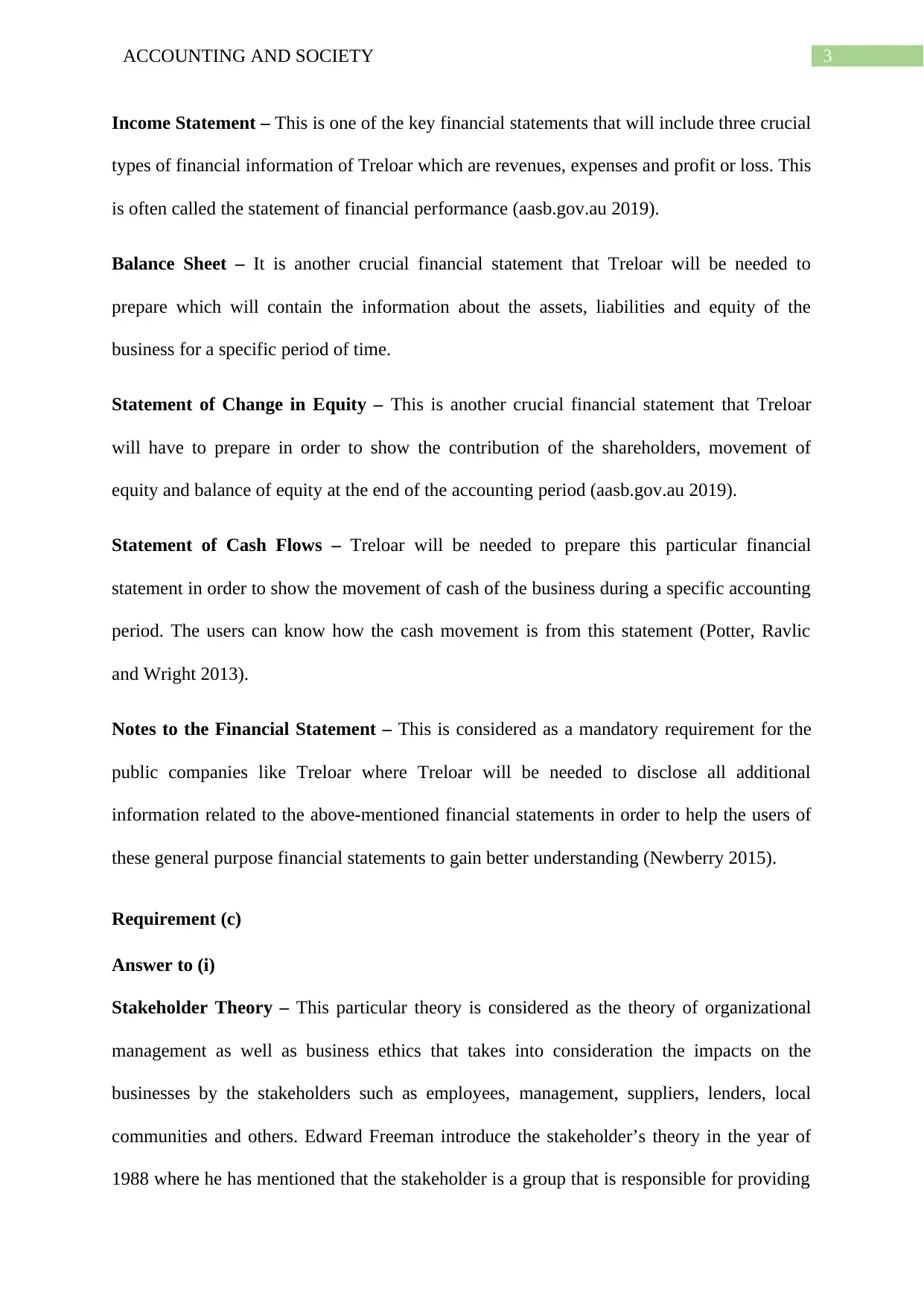
3ACCOUNTING AND SOCIETY
Income Statement – This is one of the key financial statements that will include three crucial
types of financial information of Treloar which are revenues, expenses and profit or loss. This
is often called the statement of financial performance (aasb.gov.au 2019).
Balance Sheet – It is another crucial financial statement that Treloar will be needed to
prepare which will contain the information about the assets, liabilities and equity of the
business for a specific period of time.
Statement of Change in Equity – This is another crucial financial statement that Treloar
will have to prepare in order to show the contribution of the shareholders, movement of
equity and balance of equity at the end of the accounting period (aasb.gov.au 2019).
Statement of Cash Flows – Treloar will be needed to prepare this particular financial
statement in order to show the movement of cash of the business during a specific accounting
period. The users can know how the cash movement is from this statement (Potter, Ravlic
and Wright 2013).
Notes to the Financial Statement – This is considered as a mandatory requirement for the
public companies like Treloar where Treloar will be needed to disclose all additional
information related to the above-mentioned financial statements in order to help the users of
these general purpose financial statements to gain better understanding (Newberry 2015).
Requirement (c)
Answer to (i)
Stakeholder Theory – This particular theory is considered as the theory of organizational
management as well as business ethics that takes into consideration the impacts on the
businesses by the stakeholders such as employees, management, suppliers, lenders, local
communities and others. Edward Freeman introduce the stakeholder’s theory in the year of
1988 where he has mentioned that the stakeholder is a group that is responsible for providing
Income Statement – This is one of the key financial statements that will include three crucial
types of financial information of Treloar which are revenues, expenses and profit or loss. This
is often called the statement of financial performance (aasb.gov.au 2019).
Balance Sheet – It is another crucial financial statement that Treloar will be needed to
prepare which will contain the information about the assets, liabilities and equity of the
business for a specific period of time.
Statement of Change in Equity – This is another crucial financial statement that Treloar
will have to prepare in order to show the contribution of the shareholders, movement of
equity and balance of equity at the end of the accounting period (aasb.gov.au 2019).
Statement of Cash Flows – Treloar will be needed to prepare this particular financial
statement in order to show the movement of cash of the business during a specific accounting
period. The users can know how the cash movement is from this statement (Potter, Ravlic
and Wright 2013).
Notes to the Financial Statement – This is considered as a mandatory requirement for the
public companies like Treloar where Treloar will be needed to disclose all additional
information related to the above-mentioned financial statements in order to help the users of
these general purpose financial statements to gain better understanding (Newberry 2015).
Requirement (c)
Answer to (i)
Stakeholder Theory – This particular theory is considered as the theory of organizational
management as well as business ethics that takes into consideration the impacts on the
businesses by the stakeholders such as employees, management, suppliers, lenders, local
communities and others. Edward Freeman introduce the stakeholder’s theory in the year of
1988 where he has mentioned that the stakeholder is a group that is responsible for providing
Secure Best Marks with AI Grader
Need help grading? Try our AI Grader for instant feedback on your assignments.
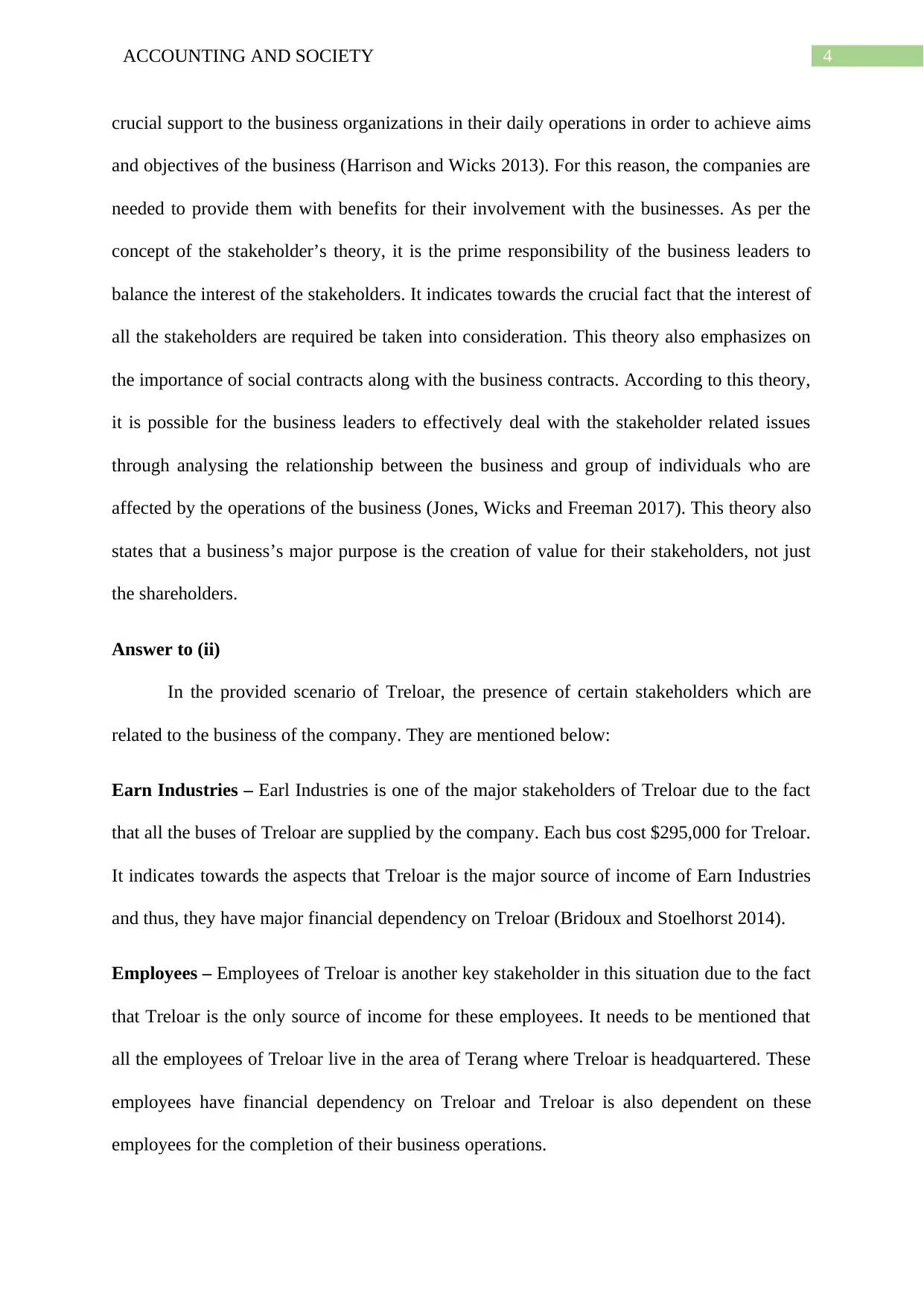
4ACCOUNTING AND SOCIETY
crucial support to the business organizations in their daily operations in order to achieve aims
and objectives of the business (Harrison and Wicks 2013). For this reason, the companies are
needed to provide them with benefits for their involvement with the businesses. As per the
concept of the stakeholder’s theory, it is the prime responsibility of the business leaders to
balance the interest of the stakeholders. It indicates towards the crucial fact that the interest of
all the stakeholders are required be taken into consideration. This theory also emphasizes on
the importance of social contracts along with the business contracts. According to this theory,
it is possible for the business leaders to effectively deal with the stakeholder related issues
through analysing the relationship between the business and group of individuals who are
affected by the operations of the business (Jones, Wicks and Freeman 2017). This theory also
states that a business’s major purpose is the creation of value for their stakeholders, not just
the shareholders.
Answer to (ii)
In the provided scenario of Treloar, the presence of certain stakeholders which are
related to the business of the company. They are mentioned below:
Earn Industries – Earl Industries is one of the major stakeholders of Treloar due to the fact
that all the buses of Treloar are supplied by the company. Each bus cost $295,000 for Treloar.
It indicates towards the aspects that Treloar is the major source of income of Earn Industries
and thus, they have major financial dependency on Treloar (Bridoux and Stoelhorst 2014).
Employees – Employees of Treloar is another key stakeholder in this situation due to the fact
that Treloar is the only source of income for these employees. It needs to be mentioned that
all the employees of Treloar live in the area of Terang where Treloar is headquartered. These
employees have financial dependency on Treloar and Treloar is also dependent on these
employees for the completion of their business operations.
crucial support to the business organizations in their daily operations in order to achieve aims
and objectives of the business (Harrison and Wicks 2013). For this reason, the companies are
needed to provide them with benefits for their involvement with the businesses. As per the
concept of the stakeholder’s theory, it is the prime responsibility of the business leaders to
balance the interest of the stakeholders. It indicates towards the crucial fact that the interest of
all the stakeholders are required be taken into consideration. This theory also emphasizes on
the importance of social contracts along with the business contracts. According to this theory,
it is possible for the business leaders to effectively deal with the stakeholder related issues
through analysing the relationship between the business and group of individuals who are
affected by the operations of the business (Jones, Wicks and Freeman 2017). This theory also
states that a business’s major purpose is the creation of value for their stakeholders, not just
the shareholders.
Answer to (ii)
In the provided scenario of Treloar, the presence of certain stakeholders which are
related to the business of the company. They are mentioned below:
Earn Industries – Earl Industries is one of the major stakeholders of Treloar due to the fact
that all the buses of Treloar are supplied by the company. Each bus cost $295,000 for Treloar.
It indicates towards the aspects that Treloar is the major source of income of Earn Industries
and thus, they have major financial dependency on Treloar (Bridoux and Stoelhorst 2014).
Employees – Employees of Treloar is another key stakeholder in this situation due to the fact
that Treloar is the only source of income for these employees. It needs to be mentioned that
all the employees of Treloar live in the area of Terang where Treloar is headquartered. These
employees have financial dependency on Treloar and Treloar is also dependent on these
employees for the completion of their business operations.
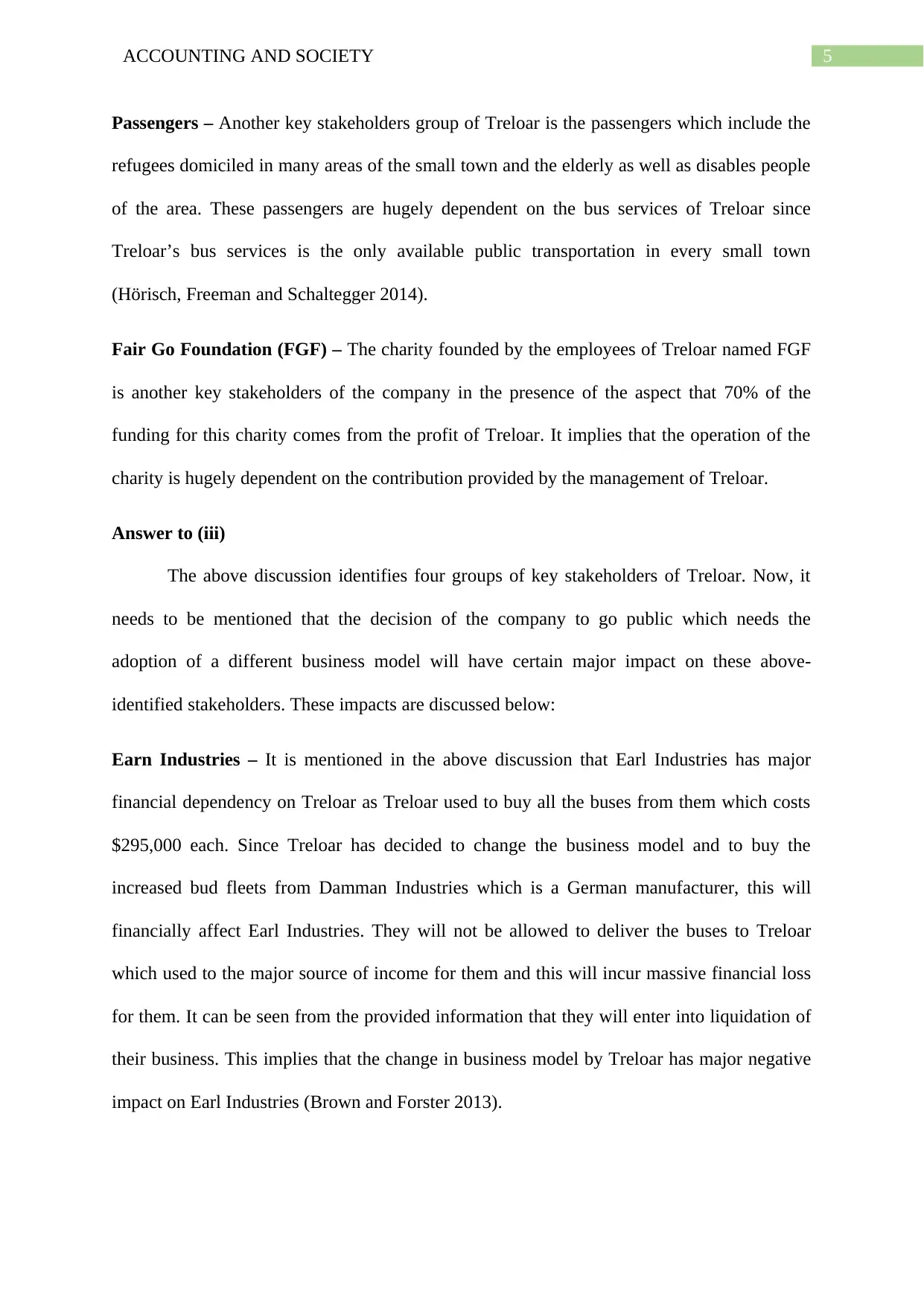
5ACCOUNTING AND SOCIETY
Passengers – Another key stakeholders group of Treloar is the passengers which include the
refugees domiciled in many areas of the small town and the elderly as well as disables people
of the area. These passengers are hugely dependent on the bus services of Treloar since
Treloar’s bus services is the only available public transportation in every small town
(Hörisch, Freeman and Schaltegger 2014).
Fair Go Foundation (FGF) – The charity founded by the employees of Treloar named FGF
is another key stakeholders of the company in the presence of the aspect that 70% of the
funding for this charity comes from the profit of Treloar. It implies that the operation of the
charity is hugely dependent on the contribution provided by the management of Treloar.
Answer to (iii)
The above discussion identifies four groups of key stakeholders of Treloar. Now, it
needs to be mentioned that the decision of the company to go public which needs the
adoption of a different business model will have certain major impact on these above-
identified stakeholders. These impacts are discussed below:
Earn Industries – It is mentioned in the above discussion that Earl Industries has major
financial dependency on Treloar as Treloar used to buy all the buses from them which costs
$295,000 each. Since Treloar has decided to change the business model and to buy the
increased bud fleets from Damman Industries which is a German manufacturer, this will
financially affect Earl Industries. They will not be allowed to deliver the buses to Treloar
which used to the major source of income for them and this will incur massive financial loss
for them. It can be seen from the provided information that they will enter into liquidation of
their business. This implies that the change in business model by Treloar has major negative
impact on Earl Industries (Brown and Forster 2013).
Passengers – Another key stakeholders group of Treloar is the passengers which include the
refugees domiciled in many areas of the small town and the elderly as well as disables people
of the area. These passengers are hugely dependent on the bus services of Treloar since
Treloar’s bus services is the only available public transportation in every small town
(Hörisch, Freeman and Schaltegger 2014).
Fair Go Foundation (FGF) – The charity founded by the employees of Treloar named FGF
is another key stakeholders of the company in the presence of the aspect that 70% of the
funding for this charity comes from the profit of Treloar. It implies that the operation of the
charity is hugely dependent on the contribution provided by the management of Treloar.
Answer to (iii)
The above discussion identifies four groups of key stakeholders of Treloar. Now, it
needs to be mentioned that the decision of the company to go public which needs the
adoption of a different business model will have certain major impact on these above-
identified stakeholders. These impacts are discussed below:
Earn Industries – It is mentioned in the above discussion that Earl Industries has major
financial dependency on Treloar as Treloar used to buy all the buses from them which costs
$295,000 each. Since Treloar has decided to change the business model and to buy the
increased bud fleets from Damman Industries which is a German manufacturer, this will
financially affect Earl Industries. They will not be allowed to deliver the buses to Treloar
which used to the major source of income for them and this will incur massive financial loss
for them. It can be seen from the provided information that they will enter into liquidation of
their business. This implies that the change in business model by Treloar has major negative
impact on Earl Industries (Brown and Forster 2013).
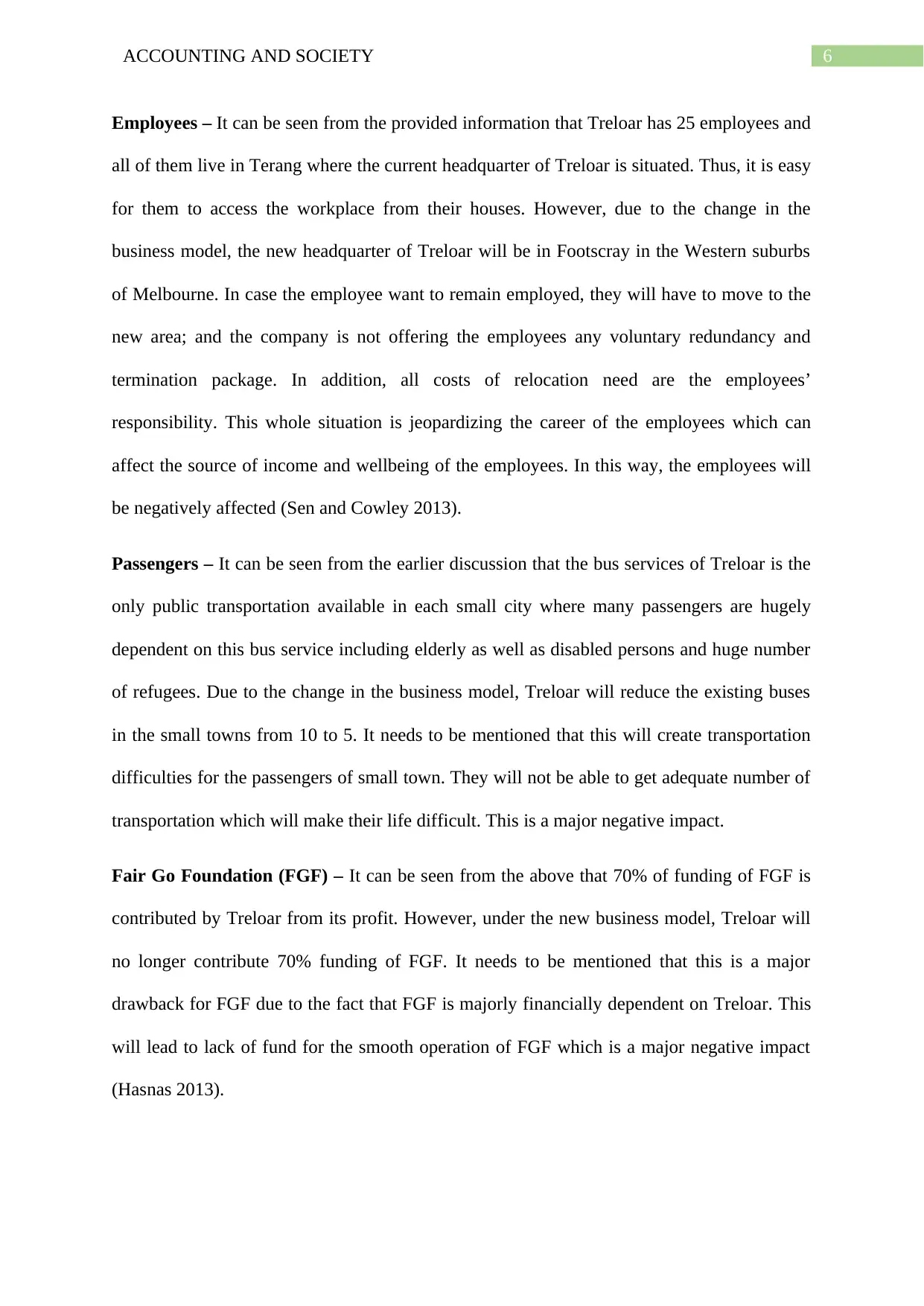
6ACCOUNTING AND SOCIETY
Employees – It can be seen from the provided information that Treloar has 25 employees and
all of them live in Terang where the current headquarter of Treloar is situated. Thus, it is easy
for them to access the workplace from their houses. However, due to the change in the
business model, the new headquarter of Treloar will be in Footscray in the Western suburbs
of Melbourne. In case the employee want to remain employed, they will have to move to the
new area; and the company is not offering the employees any voluntary redundancy and
termination package. In addition, all costs of relocation need are the employees’
responsibility. This whole situation is jeopardizing the career of the employees which can
affect the source of income and wellbeing of the employees. In this way, the employees will
be negatively affected (Sen and Cowley 2013).
Passengers – It can be seen from the earlier discussion that the bus services of Treloar is the
only public transportation available in each small city where many passengers are hugely
dependent on this bus service including elderly as well as disabled persons and huge number
of refugees. Due to the change in the business model, Treloar will reduce the existing buses
in the small towns from 10 to 5. It needs to be mentioned that this will create transportation
difficulties for the passengers of small town. They will not be able to get adequate number of
transportation which will make their life difficult. This is a major negative impact.
Fair Go Foundation (FGF) – It can be seen from the above that 70% of funding of FGF is
contributed by Treloar from its profit. However, under the new business model, Treloar will
no longer contribute 70% funding of FGF. It needs to be mentioned that this is a major
drawback for FGF due to the fact that FGF is majorly financially dependent on Treloar. This
will lead to lack of fund for the smooth operation of FGF which is a major negative impact
(Hasnas 2013).
Employees – It can be seen from the provided information that Treloar has 25 employees and
all of them live in Terang where the current headquarter of Treloar is situated. Thus, it is easy
for them to access the workplace from their houses. However, due to the change in the
business model, the new headquarter of Treloar will be in Footscray in the Western suburbs
of Melbourne. In case the employee want to remain employed, they will have to move to the
new area; and the company is not offering the employees any voluntary redundancy and
termination package. In addition, all costs of relocation need are the employees’
responsibility. This whole situation is jeopardizing the career of the employees which can
affect the source of income and wellbeing of the employees. In this way, the employees will
be negatively affected (Sen and Cowley 2013).
Passengers – It can be seen from the earlier discussion that the bus services of Treloar is the
only public transportation available in each small city where many passengers are hugely
dependent on this bus service including elderly as well as disabled persons and huge number
of refugees. Due to the change in the business model, Treloar will reduce the existing buses
in the small towns from 10 to 5. It needs to be mentioned that this will create transportation
difficulties for the passengers of small town. They will not be able to get adequate number of
transportation which will make their life difficult. This is a major negative impact.
Fair Go Foundation (FGF) – It can be seen from the above that 70% of funding of FGF is
contributed by Treloar from its profit. However, under the new business model, Treloar will
no longer contribute 70% funding of FGF. It needs to be mentioned that this is a major
drawback for FGF due to the fact that FGF is majorly financially dependent on Treloar. This
will lead to lack of fund for the smooth operation of FGF which is a major negative impact
(Hasnas 2013).
Paraphrase This Document
Need a fresh take? Get an instant paraphrase of this document with our AI Paraphraser
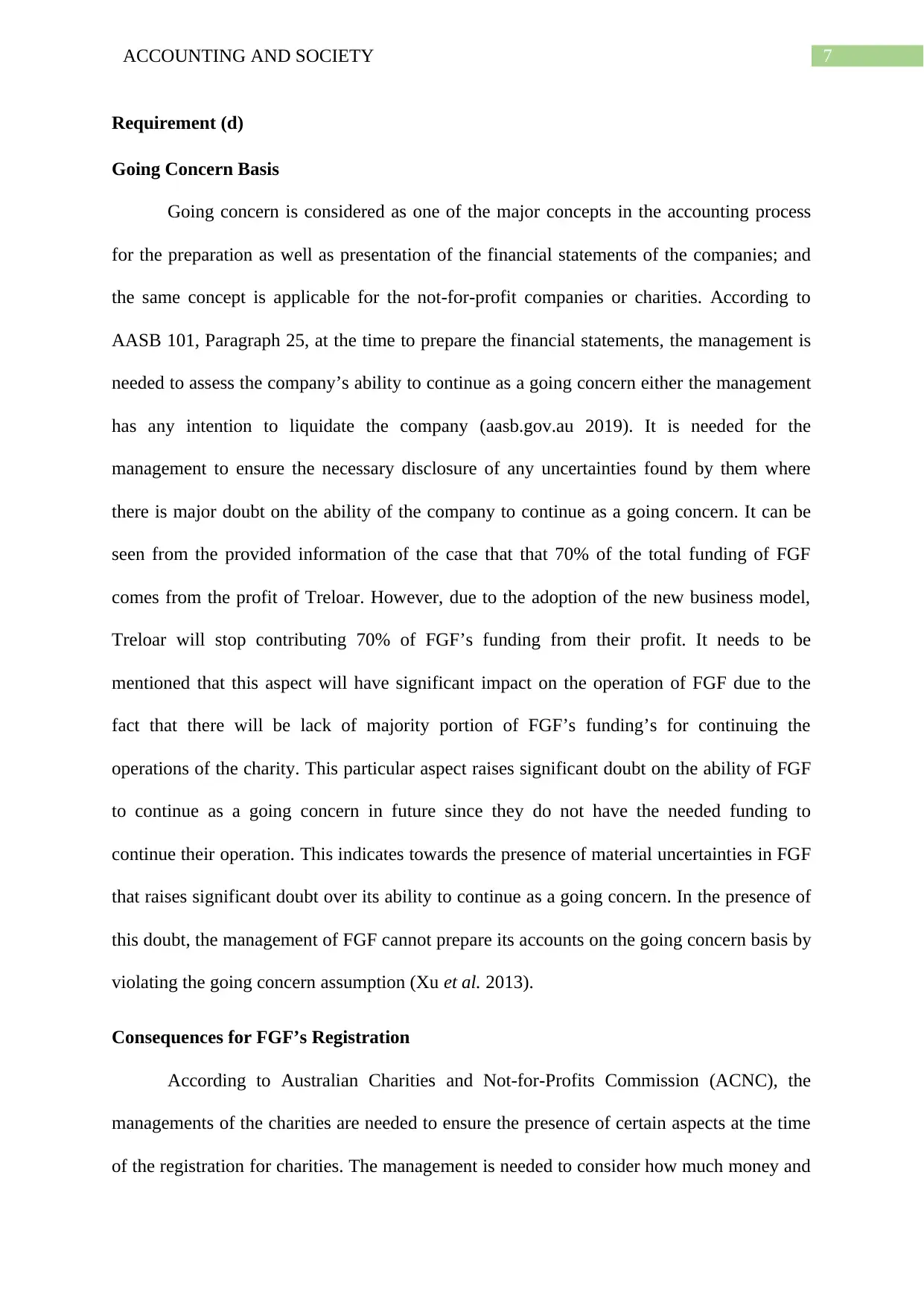
7ACCOUNTING AND SOCIETY
Requirement (d)
Going Concern Basis
Going concern is considered as one of the major concepts in the accounting process
for the preparation as well as presentation of the financial statements of the companies; and
the same concept is applicable for the not-for-profit companies or charities. According to
AASB 101, Paragraph 25, at the time to prepare the financial statements, the management is
needed to assess the company’s ability to continue as a going concern either the management
has any intention to liquidate the company (aasb.gov.au 2019). It is needed for the
management to ensure the necessary disclosure of any uncertainties found by them where
there is major doubt on the ability of the company to continue as a going concern. It can be
seen from the provided information of the case that that 70% of the total funding of FGF
comes from the profit of Treloar. However, due to the adoption of the new business model,
Treloar will stop contributing 70% of FGF’s funding from their profit. It needs to be
mentioned that this aspect will have significant impact on the operation of FGF due to the
fact that there will be lack of majority portion of FGF’s funding’s for continuing the
operations of the charity. This particular aspect raises significant doubt on the ability of FGF
to continue as a going concern in future since they do not have the needed funding to
continue their operation. This indicates towards the presence of material uncertainties in FGF
that raises significant doubt over its ability to continue as a going concern. In the presence of
this doubt, the management of FGF cannot prepare its accounts on the going concern basis by
violating the going concern assumption (Xu et al. 2013).
Consequences for FGF’s Registration
According to Australian Charities and Not-for-Profits Commission (ACNC), the
managements of the charities are needed to ensure the presence of certain aspects at the time
of the registration for charities. The management is needed to consider how much money and
Requirement (d)
Going Concern Basis
Going concern is considered as one of the major concepts in the accounting process
for the preparation as well as presentation of the financial statements of the companies; and
the same concept is applicable for the not-for-profit companies or charities. According to
AASB 101, Paragraph 25, at the time to prepare the financial statements, the management is
needed to assess the company’s ability to continue as a going concern either the management
has any intention to liquidate the company (aasb.gov.au 2019). It is needed for the
management to ensure the necessary disclosure of any uncertainties found by them where
there is major doubt on the ability of the company to continue as a going concern. It can be
seen from the provided information of the case that that 70% of the total funding of FGF
comes from the profit of Treloar. However, due to the adoption of the new business model,
Treloar will stop contributing 70% of FGF’s funding from their profit. It needs to be
mentioned that this aspect will have significant impact on the operation of FGF due to the
fact that there will be lack of majority portion of FGF’s funding’s for continuing the
operations of the charity. This particular aspect raises significant doubt on the ability of FGF
to continue as a going concern in future since they do not have the needed funding to
continue their operation. This indicates towards the presence of material uncertainties in FGF
that raises significant doubt over its ability to continue as a going concern. In the presence of
this doubt, the management of FGF cannot prepare its accounts on the going concern basis by
violating the going concern assumption (Xu et al. 2013).
Consequences for FGF’s Registration
According to Australian Charities and Not-for-Profits Commission (ACNC), the
managements of the charities are needed to ensure the presence of certain aspects at the time
of the registration for charities. The management is needed to consider how much money and
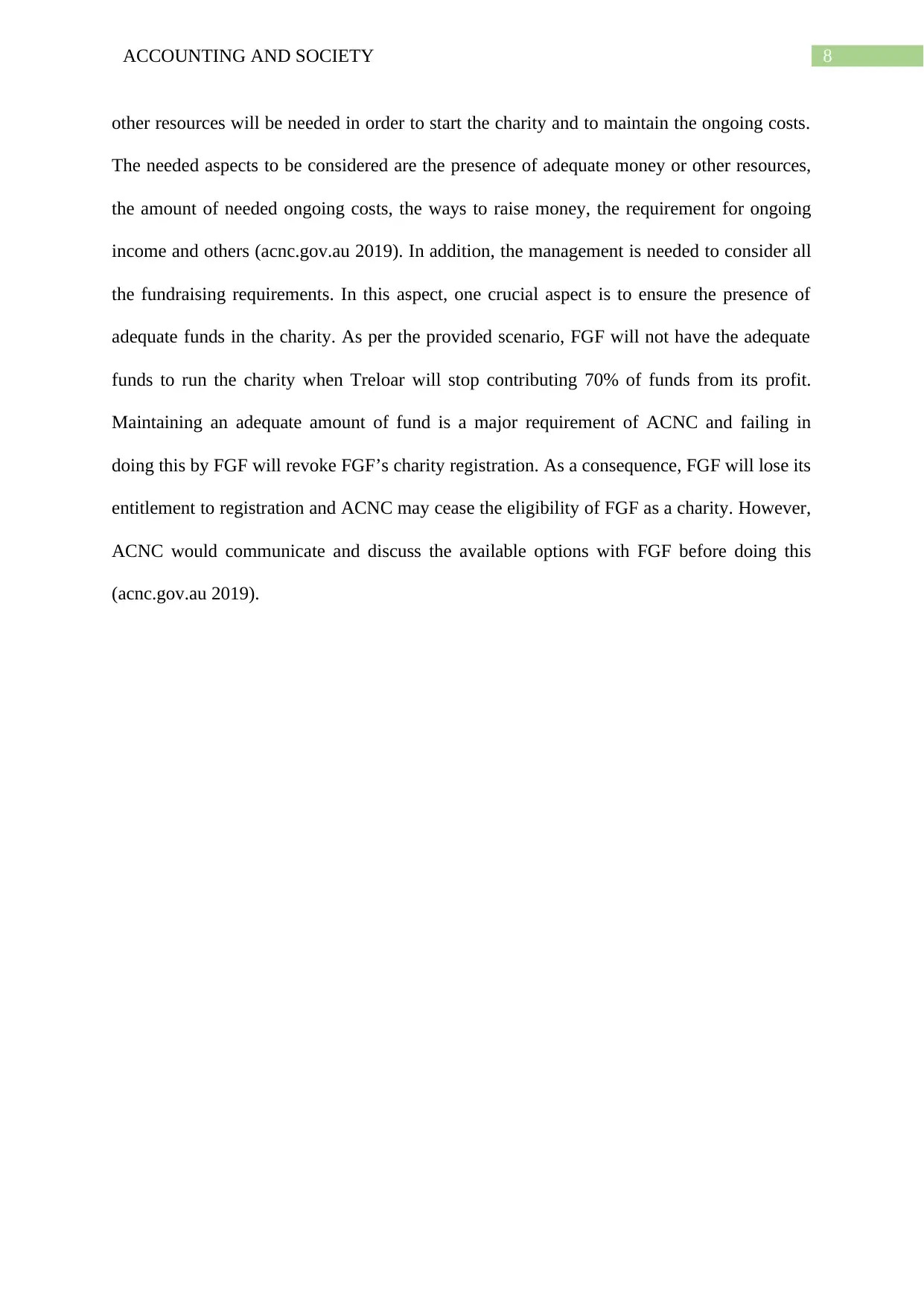
8ACCOUNTING AND SOCIETY
other resources will be needed in order to start the charity and to maintain the ongoing costs.
The needed aspects to be considered are the presence of adequate money or other resources,
the amount of needed ongoing costs, the ways to raise money, the requirement for ongoing
income and others (acnc.gov.au 2019). In addition, the management is needed to consider all
the fundraising requirements. In this aspect, one crucial aspect is to ensure the presence of
adequate funds in the charity. As per the provided scenario, FGF will not have the adequate
funds to run the charity when Treloar will stop contributing 70% of funds from its profit.
Maintaining an adequate amount of fund is a major requirement of ACNC and failing in
doing this by FGF will revoke FGF’s charity registration. As a consequence, FGF will lose its
entitlement to registration and ACNC may cease the eligibility of FGF as a charity. However,
ACNC would communicate and discuss the available options with FGF before doing this
(acnc.gov.au 2019).
other resources will be needed in order to start the charity and to maintain the ongoing costs.
The needed aspects to be considered are the presence of adequate money or other resources,
the amount of needed ongoing costs, the ways to raise money, the requirement for ongoing
income and others (acnc.gov.au 2019). In addition, the management is needed to consider all
the fundraising requirements. In this aspect, one crucial aspect is to ensure the presence of
adequate funds in the charity. As per the provided scenario, FGF will not have the adequate
funds to run the charity when Treloar will stop contributing 70% of funds from its profit.
Maintaining an adequate amount of fund is a major requirement of ACNC and failing in
doing this by FGF will revoke FGF’s charity registration. As a consequence, FGF will lose its
entitlement to registration and ACNC may cease the eligibility of FGF as a charity. However,
ACNC would communicate and discuss the available options with FGF before doing this
(acnc.gov.au 2019).
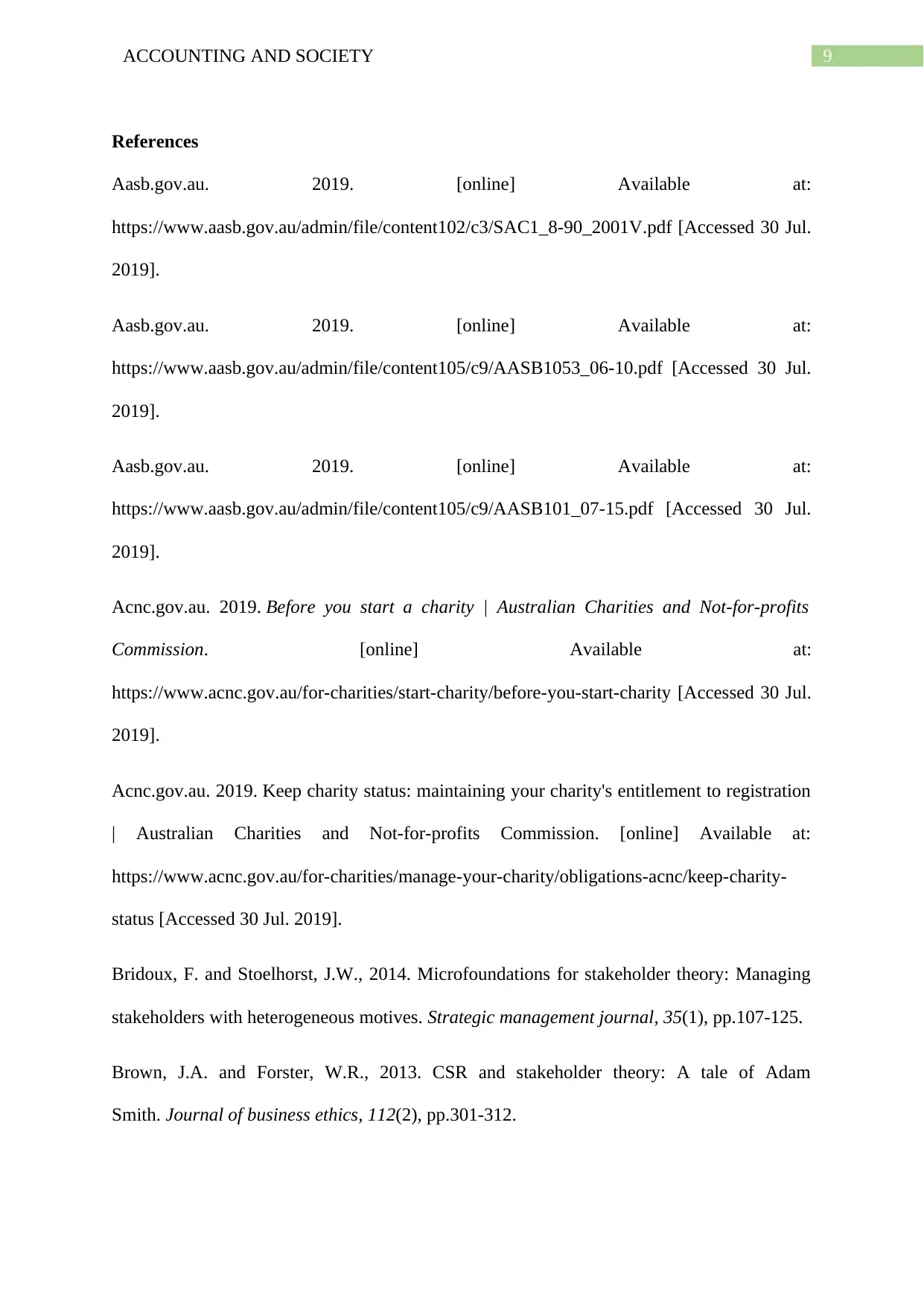
9ACCOUNTING AND SOCIETY
References
Aasb.gov.au. 2019. [online] Available at:
https://www.aasb.gov.au/admin/file/content102/c3/SAC1_8-90_2001V.pdf [Accessed 30 Jul.
2019].
Aasb.gov.au. 2019. [online] Available at:
https://www.aasb.gov.au/admin/file/content105/c9/AASB1053_06-10.pdf [Accessed 30 Jul.
2019].
Aasb.gov.au. 2019. [online] Available at:
https://www.aasb.gov.au/admin/file/content105/c9/AASB101_07-15.pdf [Accessed 30 Jul.
2019].
Acnc.gov.au. 2019. Before you start a charity | Australian Charities and Not-for-profits
Commission. [online] Available at:
https://www.acnc.gov.au/for-charities/start-charity/before-you-start-charity [Accessed 30 Jul.
2019].
Acnc.gov.au. 2019. Keep charity status: maintaining your charity's entitlement to registration
| Australian Charities and Not-for-profits Commission. [online] Available at:
https://www.acnc.gov.au/for-charities/manage-your-charity/obligations-acnc/keep-charity-
status [Accessed 30 Jul. 2019].
Bridoux, F. and Stoelhorst, J.W., 2014. Microfoundations for stakeholder theory: Managing
stakeholders with heterogeneous motives. Strategic management journal, 35(1), pp.107-125.
Brown, J.A. and Forster, W.R., 2013. CSR and stakeholder theory: A tale of Adam
Smith. Journal of business ethics, 112(2), pp.301-312.
References
Aasb.gov.au. 2019. [online] Available at:
https://www.aasb.gov.au/admin/file/content102/c3/SAC1_8-90_2001V.pdf [Accessed 30 Jul.
2019].
Aasb.gov.au. 2019. [online] Available at:
https://www.aasb.gov.au/admin/file/content105/c9/AASB1053_06-10.pdf [Accessed 30 Jul.
2019].
Aasb.gov.au. 2019. [online] Available at:
https://www.aasb.gov.au/admin/file/content105/c9/AASB101_07-15.pdf [Accessed 30 Jul.
2019].
Acnc.gov.au. 2019. Before you start a charity | Australian Charities and Not-for-profits
Commission. [online] Available at:
https://www.acnc.gov.au/for-charities/start-charity/before-you-start-charity [Accessed 30 Jul.
2019].
Acnc.gov.au. 2019. Keep charity status: maintaining your charity's entitlement to registration
| Australian Charities and Not-for-profits Commission. [online] Available at:
https://www.acnc.gov.au/for-charities/manage-your-charity/obligations-acnc/keep-charity-
status [Accessed 30 Jul. 2019].
Bridoux, F. and Stoelhorst, J.W., 2014. Microfoundations for stakeholder theory: Managing
stakeholders with heterogeneous motives. Strategic management journal, 35(1), pp.107-125.
Brown, J.A. and Forster, W.R., 2013. CSR and stakeholder theory: A tale of Adam
Smith. Journal of business ethics, 112(2), pp.301-312.
Secure Best Marks with AI Grader
Need help grading? Try our AI Grader for instant feedback on your assignments.
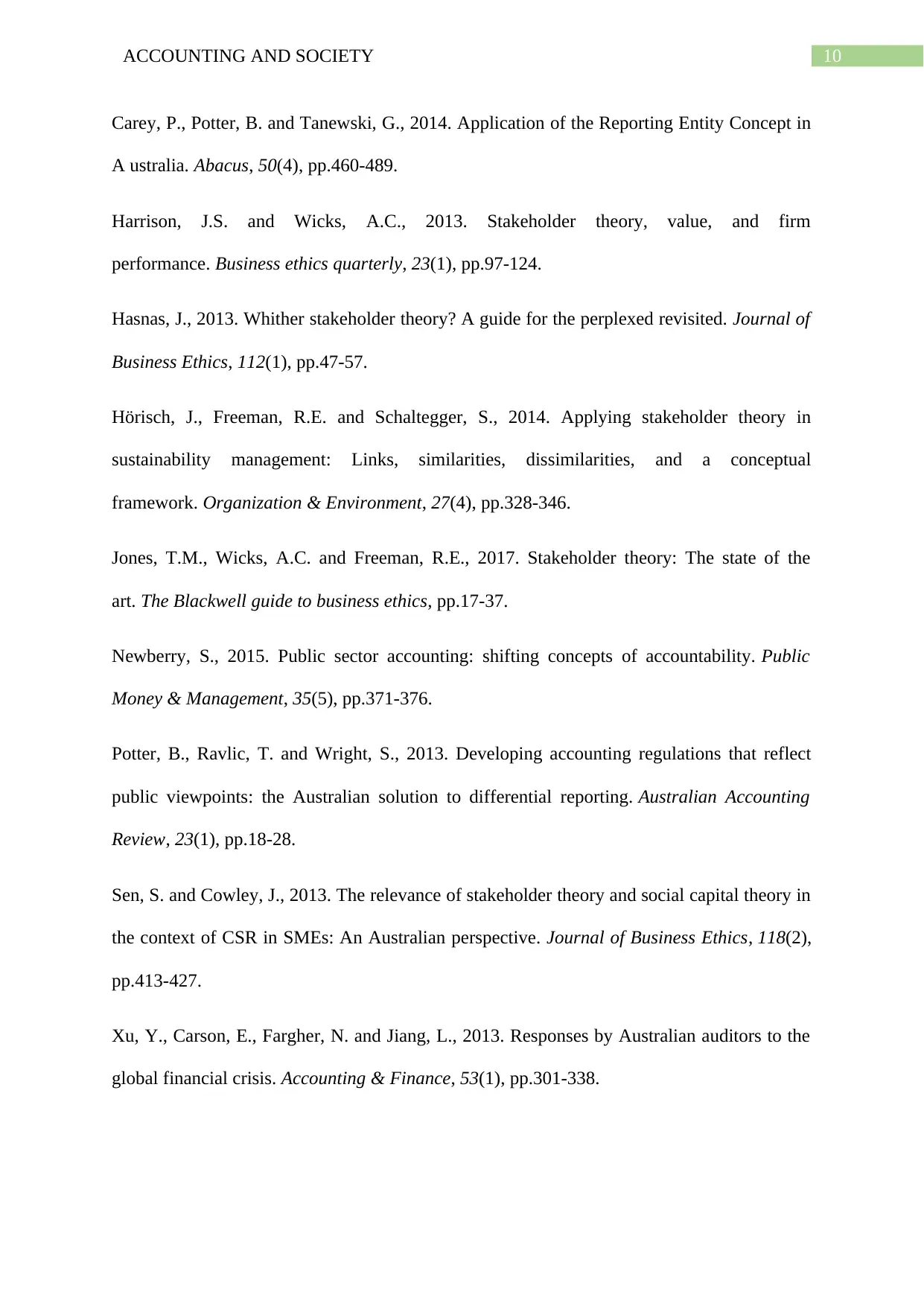
10ACCOUNTING AND SOCIETY
Carey, P., Potter, B. and Tanewski, G., 2014. Application of the Reporting Entity Concept in
A ustralia. Abacus, 50(4), pp.460-489.
Harrison, J.S. and Wicks, A.C., 2013. Stakeholder theory, value, and firm
performance. Business ethics quarterly, 23(1), pp.97-124.
Hasnas, J., 2013. Whither stakeholder theory? A guide for the perplexed revisited. Journal of
Business Ethics, 112(1), pp.47-57.
Hörisch, J., Freeman, R.E. and Schaltegger, S., 2014. Applying stakeholder theory in
sustainability management: Links, similarities, dissimilarities, and a conceptual
framework. Organization & Environment, 27(4), pp.328-346.
Jones, T.M., Wicks, A.C. and Freeman, R.E., 2017. Stakeholder theory: The state of the
art. The Blackwell guide to business ethics, pp.17-37.
Newberry, S., 2015. Public sector accounting: shifting concepts of accountability. Public
Money & Management, 35(5), pp.371-376.
Potter, B., Ravlic, T. and Wright, S., 2013. Developing accounting regulations that reflect
public viewpoints: the Australian solution to differential reporting. Australian Accounting
Review, 23(1), pp.18-28.
Sen, S. and Cowley, J., 2013. The relevance of stakeholder theory and social capital theory in
the context of CSR in SMEs: An Australian perspective. Journal of Business Ethics, 118(2),
pp.413-427.
Xu, Y., Carson, E., Fargher, N. and Jiang, L., 2013. Responses by Australian auditors to the
global financial crisis. Accounting & Finance, 53(1), pp.301-338.
Carey, P., Potter, B. and Tanewski, G., 2014. Application of the Reporting Entity Concept in
A ustralia. Abacus, 50(4), pp.460-489.
Harrison, J.S. and Wicks, A.C., 2013. Stakeholder theory, value, and firm
performance. Business ethics quarterly, 23(1), pp.97-124.
Hasnas, J., 2013. Whither stakeholder theory? A guide for the perplexed revisited. Journal of
Business Ethics, 112(1), pp.47-57.
Hörisch, J., Freeman, R.E. and Schaltegger, S., 2014. Applying stakeholder theory in
sustainability management: Links, similarities, dissimilarities, and a conceptual
framework. Organization & Environment, 27(4), pp.328-346.
Jones, T.M., Wicks, A.C. and Freeman, R.E., 2017. Stakeholder theory: The state of the
art. The Blackwell guide to business ethics, pp.17-37.
Newberry, S., 2015. Public sector accounting: shifting concepts of accountability. Public
Money & Management, 35(5), pp.371-376.
Potter, B., Ravlic, T. and Wright, S., 2013. Developing accounting regulations that reflect
public viewpoints: the Australian solution to differential reporting. Australian Accounting
Review, 23(1), pp.18-28.
Sen, S. and Cowley, J., 2013. The relevance of stakeholder theory and social capital theory in
the context of CSR in SMEs: An Australian perspective. Journal of Business Ethics, 118(2),
pp.413-427.
Xu, Y., Carson, E., Fargher, N. and Jiang, L., 2013. Responses by Australian auditors to the
global financial crisis. Accounting & Finance, 53(1), pp.301-338.
1 out of 11
Related Documents
Your All-in-One AI-Powered Toolkit for Academic Success.
+13062052269
info@desklib.com
Available 24*7 on WhatsApp / Email
![[object Object]](/_next/static/media/star-bottom.7253800d.svg)
Unlock your academic potential
© 2024 | Zucol Services PVT LTD | All rights reserved.





